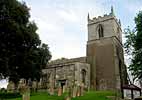 Gringley on the Hill Gringley on the Hill
St Peter and St Paul
Glass
There is stained glass in four windows.
Chancel
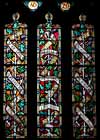 Window in the Window in the
chancel south wall |
The earliest stained glass dates from 1870, and is in memory of John Spencer, a local farmer. It is located in the westernmost of the windows on the south side of the chancel.
The window contains three brightly coloured panels depicting fruiting vines, entwined with scrolls which read ‘I am the Resurrection and the Life. Because I live ye shall live also. He that believeth in Me though he were dead yet shall he live’.
Alpha and omega are incorporated in the upper lights.
South Aisle
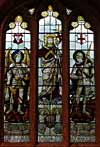 |
 Detail showing Christ Detail showing Christ |
 St Michael St Michael |
 St George St George |
The stained glass in the east window of the south aisle is the war memorial. It dates from 1920 and depicts the Benediction, with Christ in majesty, flanked by St Michael and St George. St Michael the Archangel is the warrior saint and also the angel of death, and is thus particularly apposite for a war memorial. He is depicted in armour with a white and purple cloak, above a vanquished dragon, and carries emblems of his two roles, namely a flaming sword and weighing scales. One side of the scale holds a weight, the other a soul. Above him is the Shield of the Trinity. St George, also a martial saint and the patron saint of England, is equally apt. He is depicted helmed, cloaked and in armour, quelling a dragon with his spear, his sword slung over his back. His cloak is white, with a blue lining and gold edging. Above him is St George’s cross. Christ is depicted in red with a white and gold cloak, in the act of giving the benediction. He stands in Heaven with two angels below Him, bearing a shield with the letters IHC, which stand for the first three letters of the name of Jesus in Greek (IHΣ). Panels below the images read:
To the greater Glory of God, the Giver of Victory and Peace, in honoured memory
of those who gave their lives in the Great War 1914-1918, and in gratitude for those
who returned in safety, this window is dedicated on the Eve of All Saints, 1920. |
North Aisle
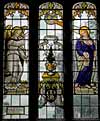 North aisle North aisle
east window |
 Angel Gabriel Angel Gabriel |
 Central light Central light |
 Virgin Mary Virgin Mary |
The easternmost window in the north wall of the north aisle contains stained glass which shows the Annunciation. The Angel Gabriel is depicted in a white robe with a purple cloak or cope, holding a golden staff. The central panel shows two angels bearing a blue shield with the initial M, and above, a vase of lilies, symbolising purity, and the inscription ‘Ave, gratia plena, Dominus tecum’ – (Hail, full of grace, the Lord is with you). Above, a dove hovers, indicating the Holy Spirit, casting rays down to the Virgin Mary to represent the Conception. She is shown in the right-hand panel, clothed in blue, with a white mantle. A small panel at the bottom of the left-hand light states that the glass was made in 1926:
A · M · D · G
GRATIARUM MULTARUM
ACTIO
M C MXXVI |
‘A.M.D.G.’ is the abbreviated form for the Latin for ‘For the Greater Glory of God’.
Lady Chapel
The stained glass in the Lady Chapel, appropriately, relates to the Virgin Mary, and is particularly fine in quality. The windows are memorials to the Butterfield family.
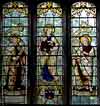 Lady Chapel Lady Chapel
east window |
 Prophet Prophet
Isaiah |
 Virgin Mary Virgin Mary
and child |
 John the John the
Baptist |
The east window in the Lady Chapel contains stained glass of 1924 depicting the Prophet Isaiah, the Virgin Mary and Child, and John the Baptist. All have halos. Isaiah is shown in the left-hand panel, clothed in red with a white cloak or cope, and carrying a scroll which reads ‘Behold a Virgin shall conceive and bear a Son’. The Virgin Mary and Child occupy the central panel, Mary in blue with a white mantle, and Jesus in purple, with angels below, bearing a blue shield with three lilies, representing Mary. John the Baptist is shown in the right-hand panel, in a red tunic and white cloak, bearing a lamb which also has a halo. A scroll reads ‘Behold the Lamb of God’.
A small panel at the bottom of the left-hand light states that the glass was made in 1924:
A · M · D · G
GRATIARUM ACTIO PRO VITA
GREENWOOD BUTTERFIELD AEDITUI
QUI OBIIT XX MAI MCMXXIV HAEC
A VIDUA ET FILIABUS PONITUR |
Windows no longer extant
There were two other example of stained glass in the church until the early years of the twentieth century. One was ‘a circular stained glass window of great beauty’ inserted as the west window in the north aisle, on behalf of Caroline Gamson of Beacon House. It was removed as part of the 1912 renovations, but is remembered by a plaque in memory of Miss Gamson’s parents. The inscription states:

NEAR TO HERE WAS A STAINED GLASS WINDOW
TO THE GLORY OF GOD
AND IN AFFECTIONATE REMEMBRANCE OF HER PARENTS
JAMES GAMSON,
BORN MARCH 27TH 1740 : DIED OCTOBER 13TH 1822.
SARAH GAMSON,
BORN AUGUST 11TH 1751 : DIED MARCH 25TH 1843,
BY CAROLINE GAMSON 1869.
“BLESSED ARE THE DEAD WHICH DIE IN THE LORD.” REV, XIV, 13.
THE WINDOW WAS REMOVED OWING TO THE REBUILDING
OF THIS WALL, 1912. |
The other was also Victorian stained glass, in a window in the south aisle, which commemorated John Hutchinson (1791-1857) and his wife Sarah (1804-1879), Joseph Bemrose (1817-1858), and John Carnell (1789-1855). It is also remembered by a plaque that reads:

NEAR HERE WAS A STAINED GLASS WINDOW
TO THE GLORY OF GOD
AND IN AFFECTIONATE REMEMBRANCE OF
| JOHN HUTCHINSON |
AND |
MARY HIS WIFE, |
BORN MARCH 5TH 1791, |
| |
BORN JUNE 11TH 1804, |
DIED JULY 3RD 1857. |
| |
DIED FEBRUARY 11TH 1879. |
JOSEPH BEMROSE, |
|
JOHN CARNALL, |
BORN JANUARY 19TH 1817, |
| |
BORN AUGUST 28TH 1789, |
DIED NOVEMBER 6TH 1858. |
| |
DIED AUGUST 16TH 1855. |
“THEY SHALL CALL HIS NAME EMMANUEL.” “GOD WITH US.”
THE WINDOW WAS REMOVED OWING TO THE BUILDING
OF THE SOUTH AISLE, 1912. |
|